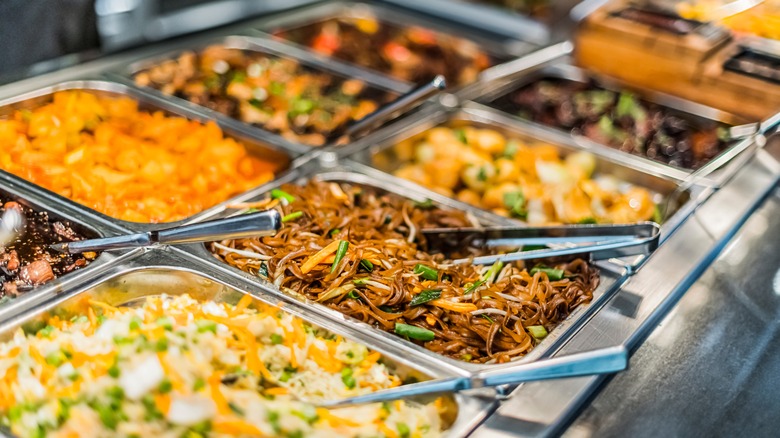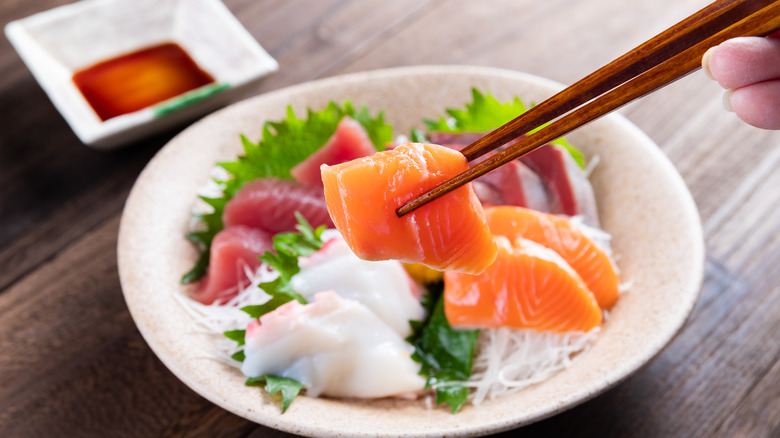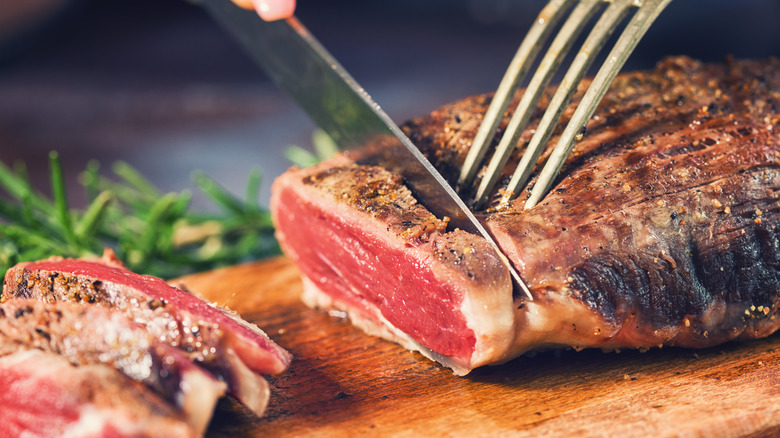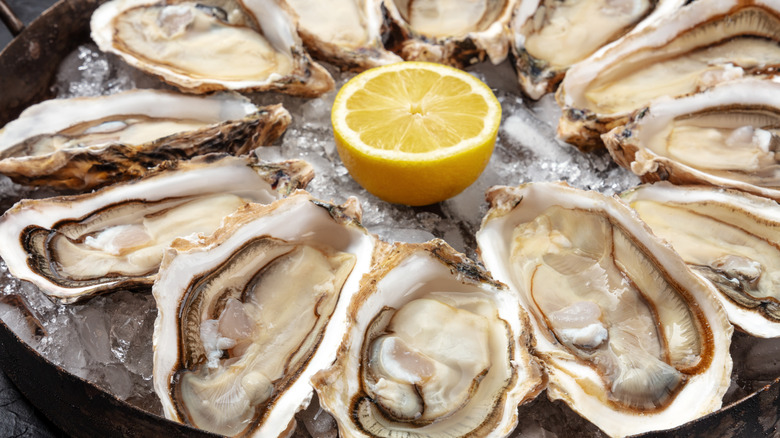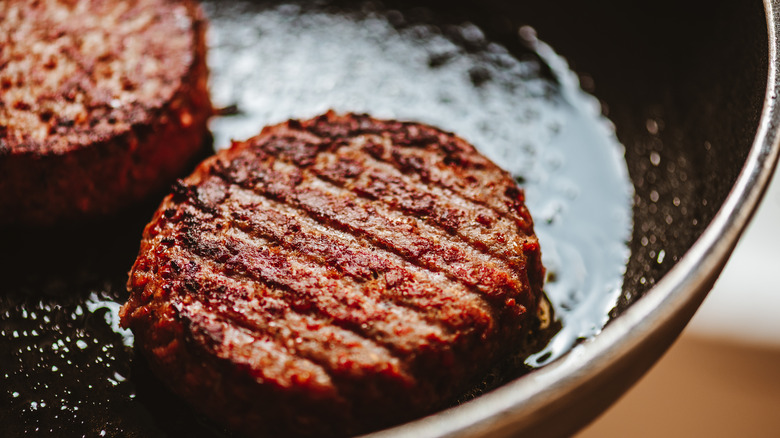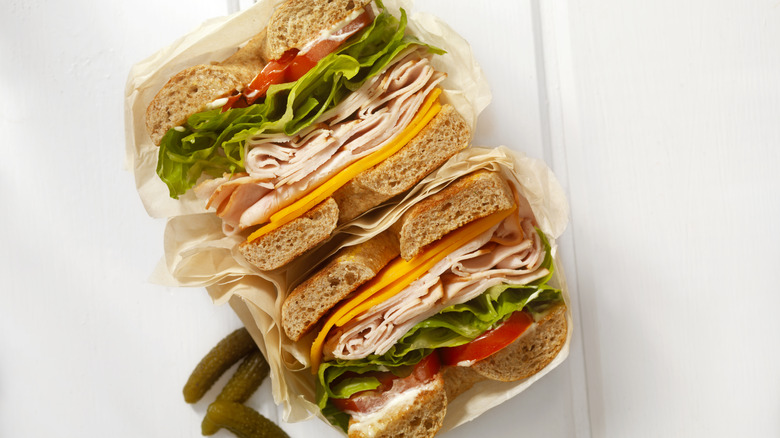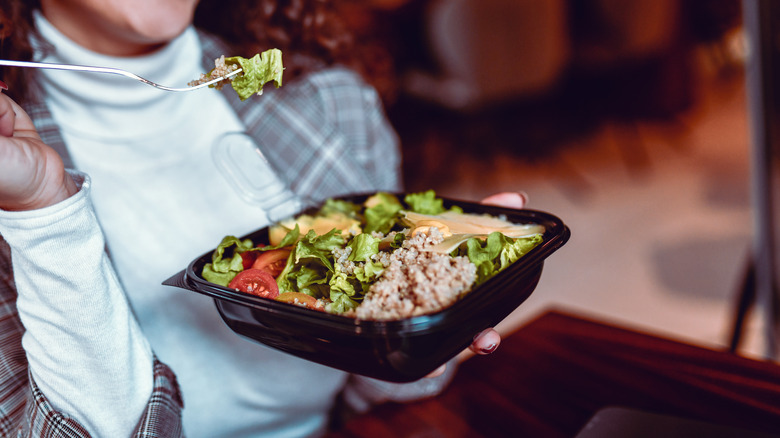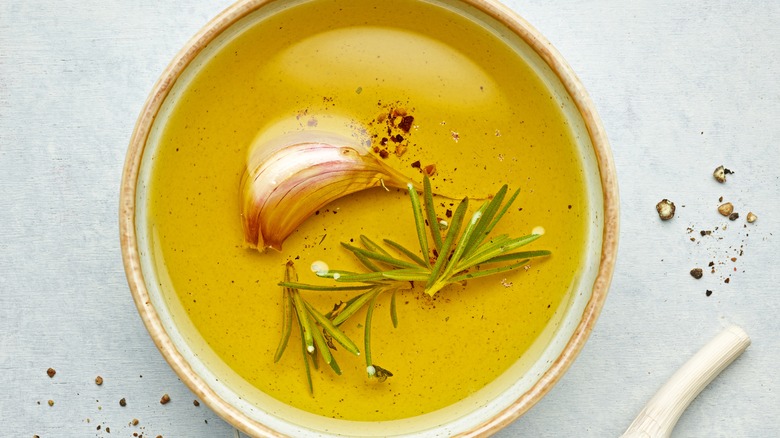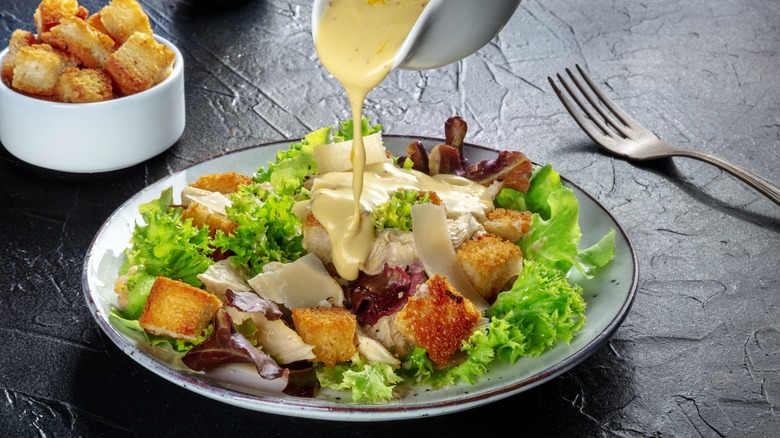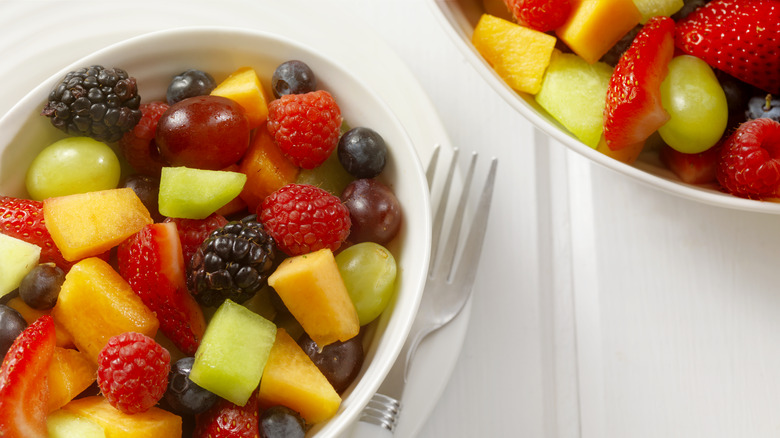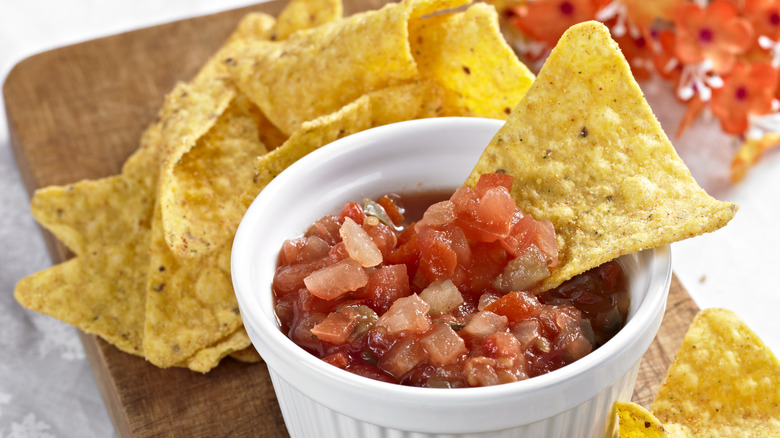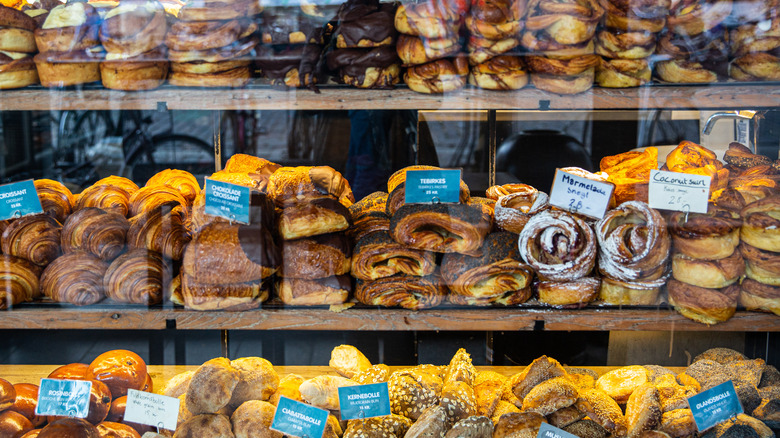The Riskiest Items On Chain Restaurant Menus
You're at your favorite chain restaurant and skip the menu because you know exactly what to order. Maybe it's that burger you've devoured countless times or the familiar Caesar salad that's never let you down. But here's the thing — there's a world of uncertainty lurking behind the delicious dishes we trust and love, and we're not talking about secret sauces.
From bacteria, parasites, empty calories, and more, our favorite chain restaurant items may be riskier than we think. It's not to say that they're always going to give us food poisoning. Dining establishments work to ensure that your experience is as safe as can be. However, there are certain foods that due to preparation methods, storage, ingredients, or other unseen factors, might have a higher chance of causing an upset stomach or worse.
In this list, we shed light on your beloved chain restaurant menu items that might not be as safe as you thought. From the all-you-can-eat buffet spread to the mysterious sushi counter, we've compiled all the hidden dangers and provided tips on how to dine with a better-safe-than-sorry philosophy. After all, what's more important than a satisfying meal is making sure your restaurant experience is both enjoyable and risk-free.
The buffet spread
Whether it's the buffet section of family-style restaurant chains or just plain old buffet restaurants, the allure of "all you can eat" is hard to resist. However, the format, where everyone digs in and serves themselves, invites a common dilemma: cross-contamination. This is when harmful microorganisms say hello from one dish and hop onto another.
Whether it's food dripping its juices onto another dish or a fellow diner with less-than-pristine hands spreading germs as they scoop out their favorites, the very nature of some buffets can turn that delectable spread into a petri dish of bacteria and viruses. Not only can the unsanitary handling of utensils and food be a playground for germs, but foods sitting out for prolonged periods or not maintained at the right temperature are prime candidates for becoming health hazards as well.
So, what's a buffet lover to do? Well, before you start piling up that plate, take a walk around. Scan the offerings, keep a keen eye on the presentation, and take note of the management's involvement. Those limp salads or dishes that seem less than ideal? Best to steer clear. While the pandemic has forced some traditional self-service buffets to change their operations to be safer, it's still crucial you keep your all-you-can-eat experience from ending in an unexpected bout of illness.
The sushi and sashimi platter
Delicate slices of fish glistening in their pure, raw form — how much fresher can it get? The surge in popularity of Japanese-style foods has seen more and more restaurants offering these delicacies on their menus. However, what many diners might not realize is the potential danger behind less-than-ideal sushi items.
From liver flukes, tapeworms, and roundworms, the idea of parasitic infections alone may be enough to put most people off. Commonly transmitted through infected water or undercooked foods like raw fish, these parasites can hitch a ride on sushi and take up residence in the next unexpecting diner. Now, while parasites might make you squeamish, bacterial infections are even sneakier. Bacteria like Vibrio, Listeria, Clostridium, and Salmonella can find their way into raw fish, leading to dreaded food poisoning symptoms — upset stomach, nausea, vomiting, and diarrhea (per Healthline).
The good news is that by always prioritizing eateries with stellar reputations for freshness and handling, as well as by knowing how to tell if your sushi rolls are fresh, you significantly slash these risks. A well-informed diner is a safe diner — and when in doubt, maybe opt for that cooked option.
The rare steak or burger
We can all agree that there's something deeply satisfying about biting into a steak or burger, especially when it's achieved that delightful rosy hue in the middle. The words "rare" or "medium-rare" promise a juiciness and flavor that's unmatched by its well-done counterparts. However, every bite of that rare red meat might just come with a side of risk.
The grinding process to make hamburger meat makes it more susceptible to foodborne bacteria, as there's an opportunity for bacteria to spread and develop when the beef is chopped up and more surface area becomes exposed. Even worse, an undercooked burger that hasn't reached an internal temperature of 160 F (per U.S. Department of Agriculture), can harbor bacteria like E. coli and salmonella.
The USDA provides some pretty clear guidelines to steer clear of raw or undercooked meat, whether it's a burger or not. It emphasizes cooking all beef, lamb, pork, and veal to a minimum internal temperature of 145 F to ensure any lurking bacteria and viruses are properly eliminated. So when the moment comes and your server, pen poised, asks, "How would you like your meat cooked?" consider that rare meat also implies a heightened risk of biting into a whole lot of pathogens. If in doubt, maybe edge towards medium doneness — there's still all of that rich flavor minus the health compromise.
The soft-boiled egg or hollandaise sauce
Whether it's the classic eggs benedict from IHOP or the hollandaise sauce-covered Classic Benny Breakfast from Denny's, delicately soft-boiled eggs are an adored feature on a breakfast plate. But we often fail to think of the hidden perils that might accompany that golden center that flows out when we pierce it.
While eggs are nutritional powerhouses, oozing with protein, vitamins, and sheer deliciousness, they can also play host to some rather unpleasant party crashers if they're raw or not fully cooked. Chickens can be carriers of salmonella bacteria, a sneaky little germ that can hitch a ride onto the eggs they produce, per the Centers for Disease Control and Prevention (CDC). According to the U.S. Food and Drug Administration (FDA), an eye-opening 79,000 cases of food poisoning each year are traced back to eggs tainted with salmonella.
So, when you're out for Sunday brunch, here's a test you should always do before gobbling down your eggs: Ensure the egg whites aren't too wobbly — no jiggling or jelly-like consistency allowed. As for the yolk, even if you revel in a bit of runniness, too much jiggling means you're entering risky territory.
For dishes with raw eggs, like a divine hollandaise sauce, be extra cautious. Opt for eateries that prioritize fresh produce and maintain rigorous safety standards. Sometimes, it's worth asking if they use pasteurized eggs, which are heat-treated to kill pathogens while retaining their raw characteristics.
The shellfish platter
From glistening oysters to sumptuous mussels, there is a luxurious allure to a platter full of shellfish. However, there are certain unwelcome souvenirs that this food might bring to the dinner table. Bivalves are natural filter feeders, constantly siphoning water to extract their food. But with this process, they can also become unwitting hosts to bacteria, like E. coli.
Moreover, some shellfish can absorb undesirable elements, potentially exposing consumers to the effects of pollution, including traces of heavy metals and industrial compounds (via The Guardian). From diarrhoetic shellfish poisoning (inflicting exactly what its name implies), paralytic shellfish poisoning (which can lead to respiratory issues), neurotoxic shellfish poisoning, and even amnesic shellfish poisoning — which can make you forget why you even started reading this list — the dangers go on and on.
But fear not! With a bit of caution, understanding, and proactive steps, you can continue enjoying the treasures of the ocean without undue risks. Dine at reputable restaurants, and for those with allergies, venture into strict kosher restaurants and vegan or vegetarian-dedicated eateries for a safe shellfish-free environment. Secondly, both the FDA and the CDC note that cooked shellfish dishes pose less risk than their raw counterparts. Finally, ask questions: Don't hesitate to inquire about the freshness and preparation of the shellfish.
The vegetarian options
For those living a meat-free lifestyle, dining out at chain restaurants as a vegetarian can often feel like tiptoeing through a minefield. Though these establishments increasingly offer vegan options, depending on the location, it's an unsettling truth that those cherished veggie patties or pizzas are often cooked on the same grill as their meaty counterparts. It's the perfect cross-contamination opportunity, and it can leave the most stringent vegetarians feeling misled.
Not only that, there's always the risk of non-vegetarian ingredients in seemingly harmless dishes. Whether it's a vegetable dish cooked in butter or meat stock, or desserts made with undisclosed gelatin, the list of undercover culprits is longer than one might expect. Some chain restaurants, while well-intentioned, may simply lack the expertise or infrastructure to cater effectively to this clientele. So, it may be up to you to speak up about your dietary preferences, ask about preparation methods, or simply stick to chains known for their vegan or vegetarian-friendly practices.
The pre-made sandwich or wrap
Watching your sandwich order being made right in front of you is a satisfaction unlike any other. However, the convenience, speed, and immediate pleasure that a pre-made sandwich or wrap offers is also undeniable. But underneath the lettuce, turkey, and cheese, you may not be privy to the fact that sandwiches are considered high-risk food items.
Aside from the fresh or raw ingredients they often contain, sandwiches usually undergo manual handling during preparation, risking contamination. Deli meats and deli-sliced cheeses are also notorious culprits of Listeria-related illnesses (via CDC). Not only can this bacteria easily spread between food, hands, and surfaces, but it can thrive and multiply even in cold refrigerators, where other germs might falter.
If that isn't enough to make you pause, Consumer Reports tested food packaging from popular food joints like Chick-fil-A, among others, and found worrisome levels of chemicals called PFAS. These "forever chemicals" are used to fend off grease and water from soaking into wrappers and cups, but they don't break down easily in the environment and can pose health concerns.
So the next time you're on the go, choose sandwiches or wraps that are made-to-order instead of pre-packaged, and ensure they are kept at proper temperatures, especially if they contain deli meats or cheeses.
The tuna or chicken salad or sandwich
Whether it's the best sandwich at your local fast-food chain or a regular old chicken salad, the components of the dish make it inherently tricky from a food safety perspective. Think about a tuna sandwich sitting on a display or an exposed chicken salad at a buffet — they are a melting pot of ingredients that can spoil in a snap. Packed with perishables, these dishes can be ticking time bombs if not handled with care.
According to the FDA, perishables like seafood and poultry shouldn't lounge at room temperature for more than two hours, especially if they're in a mayo-based dressing. Bacteria thrive between 40 F and 140 F, and they can double their numbers in just 20 minutes. The risk becomes even more pronounced in hotter conditions. At temperatures over 90 F, perishable foods like these salads should find their way to a refrigerator within an hour. Any longer than that? It's better to play it safe and not touch it at all.
To keep yourself safe when you just can't resist the tuna or chicken salad or sandwich, ask the staff how long it has been out. If it's fresh, ensure you eat it within an hour or keep it cool.
The raw garlic and herb oil appetizer
Whether it's bread dipped in herbs and oil, spaghetti doused in raw garlic and herb oil, or garlic confit, these appetizers not only promise an aromatic and fresh burst of flavor, but they might also make you susceptible to some very rare illnesses. Researchers from the University of Georgia found that when you store garlic and oil at room temperature, you inadvertently create a playground for some not-so-friendly bacteria such as Clostridium botulinum — the culprit behind botulism (via USDA). This isn't some run-of-the-mill food poisoning, since botulism can be potentially fatal.
But you don't have to swear off this delightful appetizer forever. In order to safely enjoy it, garlic-infused oil should be whipped up fresh and stored at a crisp 40 F or lower. Many restaurants understand the potential risks associated with such dishes and have strict protocols in place to ensure their garlic and herb oil preparations are fresh and stored correctly. Nevertheless, it doesn't hurt to double-check.
The Caesar salad
As a staple on chain restaurant menus, you might have never guessed that this classic dish can pose any risk at all. But here's a fun fact: The creaminess of this signature salad dressing is largely thanks to raw or partially cooked egg yolks, which not only emulsify the dressing but can also unfortunately bring potential salmonella risk.
We all know that salmonella causes diarrhea, fever, and stomach cramps (via Mayo Clinic). But how likely is a random Caesar salad going to cause all that? Well, if a salad dressing is crafted with organic, free-range, or pasteurized eggs, your risk significantly drops. But with the large volumes and cost efficiencies associated with chain restaurants, it might not always be clear what kind of eggs they're using in that delectable dressing.
When ordering, don't hesitate to ask about the source of the eggs used. Secondly, if you're still uncertain but aren't ready to part from your beloved Caesar, consider opting for a version of the salad that uses a different type of dressing, one without raw eggs.
The pre-cut fruits
Loaded into fruit salads, blended into tropical drinks, or simply packed for you to absentmindedly munch on, pre-cut fruits are convenient, delicious, and ... healthy? Well, it depends. Before you dive into that bowl of vibrant, juicy goodness, it's worth pondering what might have gone on before those pieces landed on your plate.
Pre-cut fruit, by virtue of being pre-cut, has been exposed to multiple surfaces, tools, and hands. The CDC notes that this heightened exposure can inadvertently introduce pathogens like E. coli and salmonella into the mix, turning what was meant to be a refreshing snack into a regrettable decision. The type of fruit is an important factor as well. Fruits grown close to the ground, such as cantaloupe, watermelon, and honeydew melon, are more susceptible to the pesky Listeria bacteria, leading them to headline some very unsavory food poisoning news.
So, the next time you're at your favorite chain restaurant, maybe think twice before reaching for that pre-cut fruit salad. Consider asking if they wash their fruits before serving, or better yet, opt for whole fruits when possible. Doing so not only reduces the chances of contamination but also helps in retaining the freshness, nutrients, and taste.
The unlimited offerings
Chain restaurants have always known how to lure us in with tantalizing deals. From endless appetizer deals and bottomless beverages, it's a feast for both our stomachs and our wallets. But behind the allure of these unlimited offerings, there are a lot of hidden dangers we might not even recognize at first glance.
For example, those seemingly endless and oh-so-addictive bowls of chips and salsa can lead to overindulgence since our brains are wired to munch on whatever's presented before us. Before you know it, you've downed a meal's worth of calories, and your main course hasn't even arrived. But it's not just about overeating. A study by Michigan State University found that a staggering 95% of people don't wash their hands adequately. Thus, those communal bowls brimming with pretzels, peanuts, or popcorn are also potential hotspots for germs and contamination.
So, before you dive into those endless baskets of chips, set a personal limit. Furthermore, if the place allows, ask for personal servings rather than partaking in communal bowls — it's just a safer bet in terms of hygiene.
The breakfast pastries
Whether it's Starbucks, Dunkin', or Panera Bread, all those buttery croissants, sweet muffins, and velvety eclairs that beckon us from behind the glass counter are the stuff of our dreams, right? Well, they are if you're not counting your calories or worrying about how long they've been sitting there.
While some breakfast options at chains may seem like a healthier choice over, say, a greasy cheeseburger, they can be just as concerning nutritionally, if not more so. Many are laden with alarmingly high amounts of sugar, fat, and sodium, which can contribute to health issues like obesity, heart disease, and diabetes, making them some of the unhealthiest breakfast choices.
But it's not just the nutritional value that's a concern. While many baked goods, like bread, muffins, and certain biscuits, are considered safe for ambient temperature storage due to their baking temperature, when we add fillings and other delectable additions to the mix — like creamy centers that are injected post-bake — the potential for contamination heightens.
There are a few steps to avoid these risks yet still indulge in our favorite desserts. If possible, inquire about their preparation and freshness, and ensure fillings are baked. Most importantly, always eat in moderation. By understanding what goes into our beloved pastries and how they're stored, we can make smarter, safer breakfast choices that are still satisfyingly sweet.

